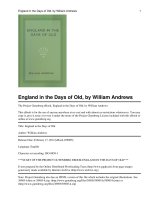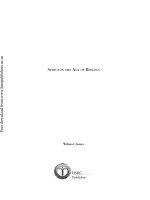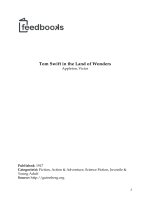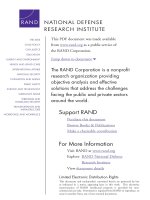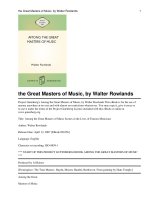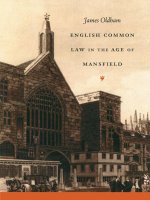Coherence in the Assessment of Writing Skill, 2008
Bạn đang xem bản rút gọn của tài liệu. Xem và tải ngay bản đầy đủ của tài liệu tại đây (151.67 KB, 11 trang )
Coherence in the assessment of
writing skills
Robin Walker and Carmen Pe
´
rez Rı
´
u
Unhappy with the contradiction of teaching writing skills through a process-genre
approach and testing them by means of a timed essay, the authors devised the
Extended Writing Project (
EWP) as an alternative evaluation mechanism. This
requires students to write an extended text in consecutive sections that are drafted
and revised with external help. At the marking stage, the final version is compared
with the drafts to gain an insight into the development of both content and
language from the planning stage to the final version. The
EWP allowed the
incorporation of process into the assessment of writing skills, and encouraged
increased learner autonomy. Despite flaws, the
EWPwas well received by students
as is reflected in a voluntary questionnaire.
Introduction A great deal of the literature on the teaching of EFL/ESL composition skills
relates to the teaching/learning process itself, and to how this may be
optimized. Deliberations as to the relative merits of process, genre, or
process-genre approaches have received attention over the last decade
(Badger and White 2000; Flowerdew 2000; Tribble 1996; Villamil and
De Guerrero 1998), as has the value of teacher- and/or peer-initiated
feedback (Frankenberg-Garcı
´
a 1999; Hyland 2000; Muncie 2000;
Rollinson 2005). In contrast, there is relatively little on options for the
assessment of composition skills, with the timed essay still the dominant
mechanism.
The impact of writing under a time restriction on the standard of the
work produced was examined some time ago by Caudery, who pointed
out that although:
the trend in language teaching is towards emphasis on the extended
composing process, there has been no concomitant trend in the
assessment of writing skills in examinations.
(Caudery 1990: 123)
Interestingly, he concluded that there was nothing to support the hypothesis
that students would write better without a time restriction. For ourselves,
however, the question is not about whether time restrictions affect
performance or not, but about the incoherence between a process-oriented
approach to teaching and a product-based approach to assessment. The
latter denies both the possibility of drafting and the chance to seek external
18 ELT Journal Volume 62/1 January 2008; doi:10.1093/elt/ccm074
ªª The Author 2008. Published by Oxford University Press; all rights reserved.
assistance, key elements in the process approach. Without external
assistance, for example, this paper would have been impossible.
Porto also perceives this drawback when she argues that ‘since timed
writing per se contradicts current research on writing pedagogy, it is
therefore inappropriate, even ( ) for evaluation purposes’ (Porto 2001: 39).
To resolve the dilemma she explored ‘cooperative writing response groups’
and self-evaluation. Her approach satisfactorily addressed ‘the constraints
of audience, purpose, time pressure, and feedback that operate and are
consistent with a view of writing as a recursive, interactive, communicative
and social activity’ (Porto ibid.: 45), but generated dissatisfaction in some
of her learners, who still had to pass a product-oriented, timed essay exam
at the end of their course.
The conflict between a process approach to teaching and a product-based,
timed essay for assessment is best described, perhaps, by Cushing:
for many teachers, particularly in academic settings, the social
aspects of writing are increasingly being recognised, and an evaluation
of writing may also include consideration of the degree to which
students have incorporated instructor and/or peer feedback in their
writing. In evaluating a final written product, thus, it is no longer
strictly the ability of the writer to use his or her own linguistic and
cognitive resources to generate appropriate texts independently that
is the issue, but rather the ability of the writer to make use of all
available resources—including social interactions—to create a text
that appropriately meets the needs of the audience and fulfils
a communicative goal.
(Cushing 2002: 178)
In our own work at the Escuela Universitaria de Turismo de Asturias,
Spain, we fully identify with this position. However, since experience in
our local context indicated that there would be significant resistance to
assessment based on group work and self-evaluation, an alternative to
Porto was required.This paper describes our attempt to find that alternative.
In particular, it evaluates the use of a piece of extended writing as
a vehicle for the simultaneous teaching and assessment of process writing
skills.
Teaching situation Our students follow a 3-year diploma course in tourism, with English
being an obligatory subject each year. English 1 and English 2 provide
100 hours’ contact in total, and English 3 brings a further 75. Course
assessment is through one of two options. In Option A, attendance in class
is not obligatory, and assessment is through a single exam at the end of the
academic year. This option is in direct response to our university exam
regulations. For Option B, attendance is obligatory, and the course is
graded using marks obtained in various ways throughout the year. In
both options students are assessed for competence in the four language
skills. Language levels among Year 3 students range from lower to
upper-intermediate, and the average group size is around 20.
Surveys have revealed that students reach the Escuela de Turismo after
some 12 years’ essentially teacher-centred language learning. Accuracy and
Coherence in assessing writing 19
form have dominated over skills acquisition and communicative efficiency,
and writing has been used to practise form rather than as a means of
communication.Given this background, in English 2 we introduce students
to the concepts of pre-writing, drafting, revising, editing and publishing
as natural, recursive steps in the creation of any written text. In line with
genre-based approaches to the teaching of writing (White and Arndt 1991;
Tribble op.cit.), students are also required to take both the reader and the
purpose ofthe text intoaccount. Thisproves newtothe vast majority, despite
which both concepts are usually well received.
However, after two years of acquiring the sub-skills of a process-genre
approach, the assessment in writing in English 3 has been, until now,
through a timed essay. In short, we have been teaching one thing and testing
another.
The extended writing
project
In an effort to resolve the teaching-testing incoherence, in English 3 we
substituted the timed essay with the Extended Writing Project (EWP),
although only in the case of students following Option B assessment, given
the need for regular contact with tutors that the Project entails.
From the outset, we saw the
EWP as having 3 main aims:
n
to resolve the incoherence between a process approach to the teaching,
and assessment through a timed essay;
n
to create a mechanism which would allow us to assess the process as well
as the product of the learner’s writing; and
n
to facilitate our students’ independence by improving their awareness
both of their writing techniques, and of the standard of their language.
A less explicit aim was to reduce the frustration felt by students and
teachers because of the marked drop in the standard of exam timed-essays
compared to coursework essays. Through the
EWP, students would now
get the chance to draft, revise, and correct a text worth 20% of their course
mark (the remaining 80% being shared equally between the other three
skills and coursework). This we hoped would motivate them to raise the
overall quality of their writing.
For the
EWP, students had to write an article of 1,000–1,200 words on
a topic of their own choosing, though clearly relevant to the broad contents
of their diploma. The article was to be written in four sections, each of
which would be read and assessed by us, their course tutors. We chose to do
this in order to push students to reflect on the problems they had had in
one section, and thus hopefully avoid repeating them in the next. Help in
identifying those problems, linguistic, organizational, or otherwise, would
come through our marking, through tutorials, or through peer feedback,
and would constitute the teaching side of the
EWP.Astudent’sabilitytouse
this information effectively in the later sections, and thus demonstrate
improved composition skills, would be part of the assessment mechanism
built into the project.
20 Robin Walker and Carmen Pe
´
rez Rı
´
u
Running the EWP In essence there were six stages to the EWP:
Stage 1
Students proposed a topic, which was accepted or not by their course
tutor on the basis of its relevance to the aims and contents of the tourism
diploma.
Stage 2
Students prepared a preliminary outline for their article. Apart from the
effect of pushing them to plan the content, this phase was important
because it:
n
provided further information on the acceptability of the topic chosen;
n
allowed us to assess the student’s ability to organize content;
n
allowed us to give guidance on research or the coherence of the text; and
n
allowed us to foresee other potential problems,
Stage 3
On completion, the first draft of the first section of the article
(approximately 200–250 words) was handed in for correction based on
criteria students were accustomed to from English 2: content, meaning,
and organization, on the one hand, and language correctness, on the
other. While revising this first draft, we left clear indications as to the place
and nature of language errors. On returning the drafts we instructed
students to record their errors, the error type (using the codes they were
already familiar with), and the correct version, on a simple error sheet—see
Appendix 1.
The main purpose of this was to raise their awareness as to individual
language problems, and thus hopefully avoid their re-occurrence. In this
respect, error had now become a teaching tool, as opposed to an indicator of
failure.
Stage 4
Students were invited to re-draft the first section of their article, correcting
language errors and using any feedback from their tutor to improve
coherence, cohesion, relevance of ideas, and so on. Once this was done
they could go on to draft the second section of their article, which we
corrected in much the same way as the first. For both of these sections, we
encouraged students to make more than one draft if they felt this to be
beneficial.
Stage 5
For the final two sections of the article, we deliberately offered less
explicit feedback with respect to language errors we had commented on
previously.Inthisway,wehopedtopushstudentstowardsincreased
responsibility, and ultimately independence, in the revision of drafts for
linguistic correctness.
In contrast, comments on aspects such as coherence and development were
still given in full, although even here students were reminded that they
themselves were responsible for the coherence of the textasa whole. Clearly,
Coherence in assessing writing 21
this was something that we could not be adequately aware of until the
article was finished; marking isolated sections of a larger text at different
moments in time made it impossible for ustoobtain a sufficiently wide view
of coherence.
Stage 6
On completion of all four sections, each student had to hand in the final
version of the whole article, together with the bibliography. The drafts and
any comments and suggestions made in tutorials were also handed in. We
insisted on this since they would give us invaluable insights into the process
behind the writing of the texts.
Despite these quite demanding conditions, we obtained a set of very
satisfactory articles, both in terms of the range of current tourism topics
covered, and in terms of the standard of the texts produced, particularly
when compared to the work students had been producing at the beginning
of the course.
Grading the articles For grading purposes, we prepared a mark sheet based on 10 criteria—see
Appendix 2. Of these, criteria 3–7 were concerned directly with the
finished text, whilst criteria 8, 9, and 10 were conceived of as relative to the
process of writing. The extent to which each of the criteria was fulfilled was
graded on a four-point scale from ‘Very much’ to ‘Not at all’. The criteria
themselves were weighted. Readability, coherence, and development (3, 4,
and 5 in the Appendix 2) were allotted 3 marks each, whilst the presentation
of the article, the range and correctness of the language, and the ‘source’
of this language (criteria 6, 7, and 8) were awarded 2 marks each. Least
importance was given to the originality of the topic, the quality of the
research, and the use of tutorial advice and the error-sheet (criteria 1, 2, 9,
and 10).
Marking involved reading a text and simultaneously assessing it on the
basis of the 10 criteria. On average this took 15–20 minutes, as compared
to 8–9 minutes for a timed essay written in exam conditions. Where
appropriate, the finished text was compared with the drafts and the
error-sheet in order to assess the writer’s effectiveness in using feedback
on the drafts during the process leading to the final version. The end
result of was a mark up to 20 maximum that reflected both product and
process.
Evaluating the EWP We opted to evaluate the EWP at two levels. Clearly, it was vital to know how
the students felt about it, whilst as course tutors we needed to assess the
degree to which we had achieved our initial aims.
The student
questionnaire
Once the finished articles had been given in, students were asked to
complete a simple questionnaire in Spanish. Five questions required
responses on a Likert-type scale, with space after each for any additional
comments. The last question invited students to offer any further
suggestions.
22 Robin Walker and Carmen Pe
´
rez Rı
´
u
table 1
Results of Qs 1–3
of the student survey
Q1 How would you assess the EWP overall in terms of learning to write in
English?
The response to this question was overwhelmingly positive, as is evident in
Table 1. In addition, various students offered comments. Four of these
referred to a change in the students’ perception of their ability to write in
English, a key aspect of the third of our initial aims. The change was best
described by the student who said ‘It helped me a lot, not only
grammatically, but also psychologically, since I could see that I can write an
article on my own’.
Other comments referred to the ability to deal with errors, also essential
with respect to the third aim: ‘You’re continually seeing mistakes, and
thanks to the error sheet you notice them’.
Q2 How do you value the
EWP as a way of assessing your writing skills in
English? Do you know of any alternative?
As with Q1, the response was clearly favourable, although this time the
comments were more diverse. One student pointed out that after 5 drafts it
seemed illogical to give a mark for writing skills, whilst a second felt the
system was good, but complained that ‘we should have seen the evaluation
criteria’. Two comments indicated the
EWP to be preferable to a timed essay,
and the fifth suggested that ‘the teacher can evaluate your progress’,
presumably as an alternative method of assessment.
Q3 How do you value the support you received from your tutor during the
writing of your project?
As tutors we were seen to be supportive of our students, with two of the four
comments indicating full satisfaction. One comment suggested that our
support was ‘in some cases a little ambiguous’, whilst another was openly
critical.
Coherence in assessing writing 23
Questions 4 and 5 (see Table 2) sought to determine, on the one hand, if
students were conscious of having learnt anything during the
EWP,andon
the other, if students felt themselves to be better equipped to face similar
tasks on their own in the future. The first of these questions relates to the
difference we hoped to establish through the
EWP with conventional
assessment, since from the outset we understood this way of working as
involving teaching as well as assessment. Question 5, of course, was an
attempt to measure student awareness of increased autonomy with respect
to writing.
Q4 Are you conscious of having improved your level of written English
thanks to what you learnt during the
EWP?
Everybody admitted to having learnt something, the majority clearly being
aware of learning having taken place. Compared to a time-restricted essay,
this would seem a very desirable situation.
Of the comments, four made reference to specific areas of language
learning. Interestingly, there was no agreement among the four about
which areas they had improved, which seems to reflect the room students
and tutors found in the
EWP to individualize their learning/teaching.
Q5 Thanks to your experience with the
EWP, do you feel yourself to be
more able to tackle work of this nature on your own in the future?
The majority of students felt the
EWP had left them much better equipped
for the future (10 students), or somewhat better equipped (17 students).
Of the first group, one student commented that she ‘will have difficulties,
but will not be afraid’, whilst of the second, another stated that ‘undoubtedly
I’ll tackle it with greater confidence and less fear’.
table 2
Results of Qs 4–5
of the student survey
24 Robin Walker and Carmen Pe
´
rez Rı
´
u
Q6 What other comments and suggestions would you like to make as to
the usefulness and workings of the
EWP?
Seventeen students made contributions to the survey through this question.
Of these, one student felt that although it had been a positive experience, ‘it
shouldn’t be such an important part of the year mark’, undoubtedly
a reference to the 20% weight this work carries. Another student was more
openly critical, complaining that the ‘structure should adjust more to the
preferences of the students, and be more flexible’. However, a number of
students reiterated their satisfaction with the new system, with one directly
challenging the previous criticism and expressing ‘satisfaction on having
had all the tourism themes available—in short, on having been able to
choose the topic’. This, of course, is a significant difference compared to the
timed essay.
Finally, numerous students suggested that the
EWP should have started
earlier, and not coincided at any time with preparation for other exams in
June.
Tutor reflections on
the
EWP
The outcome of the project was more than satisfactory if we consider the
first of our aims. Through the EWP we had eliminated the inconsistency
between our teaching of process writing skills and their assessment by
means of a timed essay. The most evidentconsequence ofthis was that given
more time to reflect on the topic, the ideas presented by the students were
more sophisticated, and were much better expressed than in timed essays.
In relation to our second aim—the development of a mechanism able to
assess both process and product—we also feel satisfied. Thanks to the
drafts, error sheets, and tutorials, we had been provided with a large amount
of data on the process itself: we had information on how the ideas had been
put together, on how each of the sections had been developed, and on how
successfully individual students had used tutorial and peer feedback.
Moreover, by means of the error sheets, we could measure their ability to
detect and solve their own language problems.
Our third aim, that of improving learner independence, had also yielded
positive results, since to a large extent each student had been responsible for
her own progress. The most tangible evidence for this claim has already
been reviewed in the analysis of the student questionnaire above. However,
in tutorials, we were also aware of their increased autonomy: students
sought help less often, and clearly controlledhigher level text skills(tone and
style, or taking the reader into account) much better.
Our fourth aim, the reduction of the frustration generated by timed essay
assessment, had obviously been fulfilled for both students and teachers. Not
only had the overall quality of the texts risen considerably, but the close
interaction with our students encouraged an atmosphere of collaboration in
the assessment process. This gave students a feeling of achievement, which
in turn increased their confidence with respect to future writing tasks, as is
also reflected in the survey.
One unexpected result was that the need to structure, organize, and draft
a fairly long text, led students to a greater awareness of each of the aspects of
writing than we had ever achieved previously. This awareness created
Coherence in assessing writing 25
conditions for meaningful learning, the product of the need to solve
problems specific to each text. That is to say, the
EWP provided ideal
circumstances for individualized learning, with students solving their own
difficulties, with or without peer or teacher help.
Despite this success, we were aware of a number of problems, either during
the writing, or at the marking stage. The
EWP requires both more time than
we had estimated, and also better timing. In addition, the
EWP demands
a close, consistent interaction between student and teacher, and this is best
done when students do not feel the pressure of exams. The outcome here
was to bring the
EWP forward to the start of the second semester.
Another important problem that arose while carrying out the
EWP was the
inadequate use of the error sheet: several students did not record language
problems adequately; others did not record them at all; a few students relied
heavily on their tutors to provide the correct forms. The explanation for this
appears to be that students found it extremely difficult to identify errors that
were not pointed out to them, or were unable to see what was wrong in
a sentence they had written themselves.
As a result of the above, we will insist on a more systematic use of the error
sheet in the future. In addition, we will make students aware of their
recurrent errors through the use of a specific symbol. Finally, we will
continue to give feedback on new errors in sections 3 and 4 of any text, whilst
being firm in our refusal to find solutions to repeated ones.
A final problem we identified concerns a certain inconsistency in the
marking scheme. We had agreed that issues such as readability, coherence,
and development were more important than others such as grammar, and
we had designed the evaluation criteria to reflect that. However, once the
final texts had been handed in, we became aware that there was a significant
difference between the work done by students who had depended heavily on
tutorial help, and that of those who had taken their work forward through
personal effort. This difference should have been brought out by the criteria
related to the evaluation of the writing process (8, 9, and 10 in the sheet).
However, these criteria had been given relatively low weightings. Obviously,
this will need to be corrected. Moreover, the use of tutorial feedback will
need to be measured more formally, through criteria that reflect both the
initial quality of each draft, and the amount of tutorial help needed to
produce the final text.
Conclusions Assessment through an impromptu timed essay is incoherent with
a process approach to teaching. In contrast, the
EWP is a system where the
evaluation of process complements that of product, where learning and
assessment concur, and where learner independence is openly fostered. We
see this as positive both for our students and for ourselves. Moreover, the
EWP supposes an important change in the roles of teachers and students
alike, with learning and collaboration taking over from teaching and
subordination.
Three evident flaws in the way we ran the
EWP are the timing, the
inadequate use of the error sheets, and the distribution of the marks.
However, these can be easily remedied by starting the
EWP earlier, by
26 Robin Walker and Carmen Pe
´
rez Rı
´
u
training students more directly in the use of the error sheets, and by
adjusting the balance in the marking scheme in order to better
accommodate the process.
Revised version received October 2005
References
Badger, R. and G. White. 2000. ‘A process genre
approach to teaching writing’.
ELT Journal 54/2:
16–26.
Caudery , T. 1990. ‘The validity of timed essay tests in
the assessment of writing skills’.
ELT Journal 44/2:
122–32.
Cushing, S. 2002. Assessing Writing. Cambridge:
Cambridge University Press.
Flowerdew, L. 2000. ‘Using a genre-based
framework to teach organizational structure in
academic writing’.
ELT Journal 54/4: 369–78.
Frankenberg-Garcı
´
a, A. 1999. ‘Providing student
writers with pre-text feedback’.
ELT Journal 53/2:
100–6.
Hyland, F. 2000. ‘
ESL writers and feedback: giving
more autonomy to students’. Language Teaching
Research 4/1: 33–54.
Muncie, J. 2000. ‘Using written teacher feedback in
EFL composition classes’. ELT Journal 54/1:
47–53.
Porto, M. 2001. ‘Cooperative writing response
groups and self-evaluation’.
ELT Journal 55/1:
38–46.
Rollinson, P. 2005. ‘Using peer feedback in the
ESL
writing class’. ELT Journal 59/1: 23–30.
Tribbl e, C. 1996. Writing. Oxford: Oxford University
Press.
White, R. and V. Ar nd t. 1991. Process Writing.Harlow:
Longman.
Villamil, O. S. and M. C. M. De Guerrero. 1998.
‘Assessing the impact of peer revision on L2 writing’.
Applied Linguistics 19/4: 491–514.
The authors
Robin Walker has worked in
ELT since 1981 and has
developed special interests in
ESP and
pronunciation. A member of the
IATEFL ESP and
Pronunciation SIGs, he is co-author of Tourism 1
(Provision)andTourism 2 (Encounters)inOUP’s
Oxford English for Careers series. After 20 years at the
Escuela Universitaria de Turismo de Asturias, he is
now a freelance teacher, teacher educator, and
materials writer.
Email:
Carmen Pe
´
rez Rı
´
u has a PhD in English Philology.
She has wide experience in teaching
ESP in tertiary
education, including English for Tourism, for
Chemistry, and for Business. She is a tutor at the
Spanish National Distance University (
UNED)and
has carried out research into different aspects of
ELT.
Email:
Appendix 1: Error
sheet
Date Section Error Type Correct form
Coherence in assessing writing 27
Appendix 2: Mark sheet
English III —Extendedwritingprojectassessment
Name Surname
Very Quite Just No
1 Is the topic chosen original? 1 0.7 0.3 0
2 Are there signs of effective research having been done? 1 0.7 0.3 0
3 Is the article immediately readable throughout? 3 2 1 0
4 Is the article coherent, with a clear structure? 3 2 1 0
5 Are the contents relevant and fully developed? 3 2 1 0
6 Is the article well presented, with visuals aiding reading? 2 1.3 0.7 0
7 Does the language used display an appropriate range of
grammar and vocabulary?
21.30.70
8 Is the language clearly the student’s own at all times? 2 1.3 0.7 0
9 Is there evidence of tutorial advice being used effectively? 1.5 1.0 0.5 0
10 Has the error chart been used efficiently and effectively,
with evidence of the student eliminating errors?
1.5 1.0 0.5 0
Totals
Final mark ¼
Additional comments
28 Robin Walker and Carmen Pe
´
rez Rı
´
u


